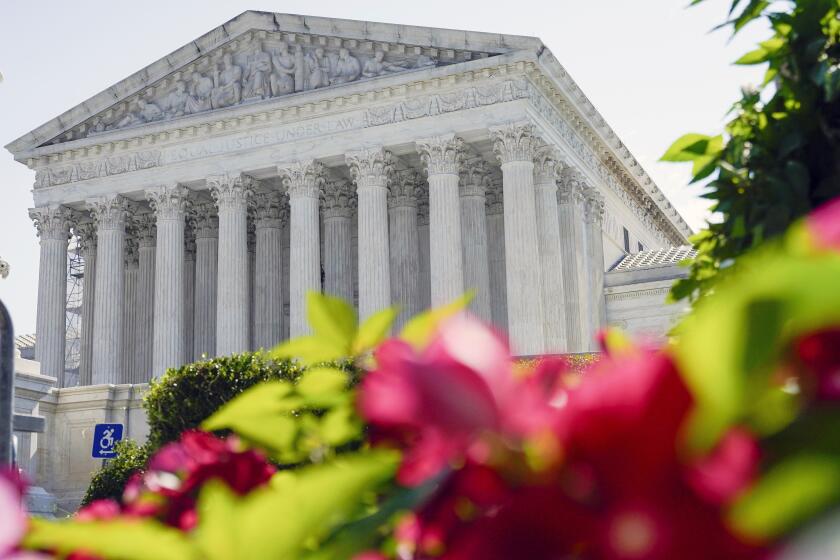Clinton Team Sees Good News in Old News
Two Cabinet-level officials and a dozen or so aides gathered Tuesday in the grandeur of the White House Roosevelt Room to proclaim the rate of homeownership in America has reached 65.6% of families--the highest level since 1980.
Sound a little familiar?
Maybe that’s because President Clinton has been declaring for months on the campaign trail--and in Orange County only last week--that “homeownership is at a 15-year high.”
Welcome to political silly season, a time when most any favorable fact is worthy of a high-level news conference and when there’s almost no limit on how often the glowing news of administration accomplishments can be recycled.
Over the last several months, Cabinet officials have held conferences to claim credit for improvements in the security of Americans’ pensions, the economic revival of U.S. cities and even a decline in the number of infants dying of sudden infant death syndrome. They have called news conferences to distribute money appropriated by Congress to farmers seeking to fend off land developers, and to cities planning to tear down decrepit public housing projects.
In recent weeks, the administration has released, accompanied by self-congratulatory comment, reports on the decline in out-of-wedlock births, the rise in incomes and the downturn in violent crime for the second year in a row.
At a rally in Miami on Tuesday, Clinton talked up the homeownership numbers touted at the White House earlier by Housing and Urban Development Secretary Henry S. Cisneros and Laura D’Andrea Tyson, director of the National Economic Council. “By the 21st century, if you’ll give us four more years, Secretary Cisneros and the rest of us who are working on this will have an all-time high of homeownership,” Clinton said, setting as a goal two of every three Americans living in their own homes.
To be sure, most experts agree that the U.S. economy is performing very well, with low unemployment and minimal inflation. And every administration uses the federal government to publicize good news--especially economic developments--and proclaim its achievements.
But the march of good news for the White House, it seems, has been relentless. And the administration has been assiduous in trumpeting that news whenever it could add luster to its record, often serving up Cabinet secretaries to reporters when a routine press release might have sufficed.
The administration considers some news releases so valuable that it trumpets them--and then trumpets them again.
With due fanfare, the Treasury Department in May announced its plans for an “inflation protection” bond for small investors. Last month, when it had put the final touches on the idea, Treasury “announced” the bond all over again, this time with Clinton on hand.
In September, Vice President Al Gore announced a series of aviation safety recommendations developed by a panel that he heads. Four days later, Clinton embraced the same recommendations in an Oval Office announcement.
Even bad news has been good news for the administration, as when the Commerce Department released a report of growing trade deficits with Japan and China. Commerce Secretary Mickey Kantor--a key strategist in Clinton’s reelection effort--was undaunted by August’s $10.8-billion trade deficit, the second-worst showing in five years.
Although Republican presidential nominee Bob Dole declared the deficits the latest evidence that “American jobs are being given away to foreign countries,” Kantor told reporters they were further evidence of the current mismatch between the booming U.S. economy and weak economies overseas.
When the Census Bureau released a report showing the first nationwide increase in incomes since 1989, Clinton said: “We are growing--and growing together.” Dole, campaigning in Florida--one of the few states where household income had declined--was reduced to carping about the state’s ill fortune.
For reporters, the significance of the economic indicators has been difficult to downplay. Relying on that, the White House has sometimes tried to use the good-news PR machine to blot out less agreeable subjects--with considerably less success.
During the Democratic convention in Chicago, White House aides tried to cut off a tumultuous press conference over news of advisor Dick Morris’ dalliance with a call girl by trotting out Clinton’s top economic advisor to dissect revised second-quarter gross domestic product figures.
To a chorus of objections from the audience, Joseph Stiglitz, chairman of the Council of Economic Advisors, sheepishly conceded: “Well . . . I know there are a lot of other things on people’s minds.”
More to Read
Get the L.A. Times Politics newsletter
Deeply reported insights into legislation, politics and policy from Sacramento, Washington and beyond. In your inbox three times per week.
You may occasionally receive promotional content from the Los Angeles Times.








